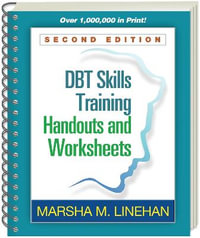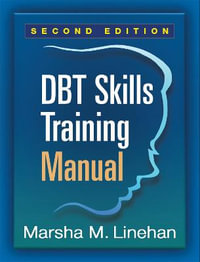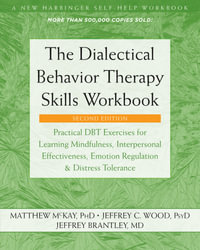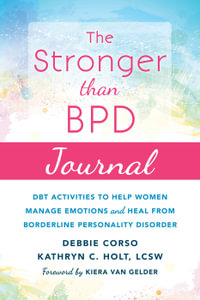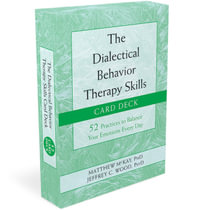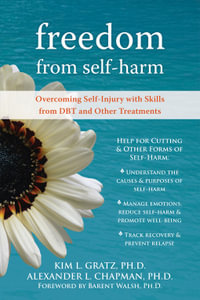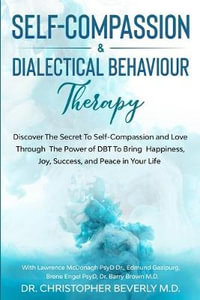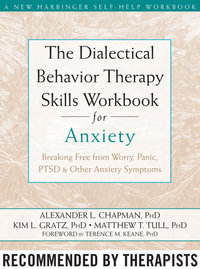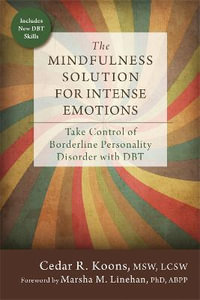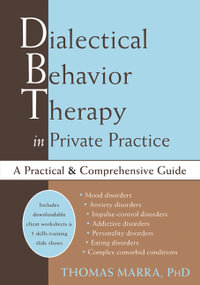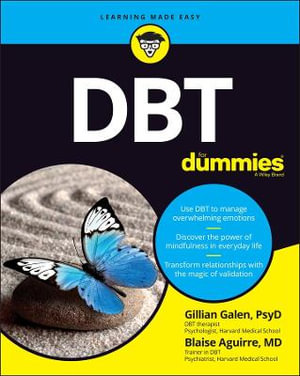
At a Glance
384 Pages
28.5 x 20.7 x 6.6
Paperback
RRP $49.95
$38.50
23%OFF
or 4 interest-free payments of $9.63 with
orWhen will this arrive by?
Keep calm, be skillful—and take control!
Dialectical Behavior Therapy (DBT) is one of the most popular—and most effective—treatments for mental health conditions that result from out-of-control emotions. Combining elements of Cognitive Behavior Therapy with Eastern mindfulness practice, DBT was initially used as a powerful treatment to address the suffering associated with borderline personality disorder. It has since proven to have positive effects on many other mental health conditions and is frequently found in non-clinical settings, such as schools. Whether you struggle with depression, anger, phobias, disordered eating, or want to have a better understanding of emotions and how to focus and calm your mind, DBT practice serves the needs of those facing anything from regular life challenges to severe psychological distress.
Written in a no-jargon, friendly style by two of Harvard Medical School's finest, DBT For Dummies shows how DBT can teach new ways not just to reverse, but to actively take control of self-destructive behaviors and negative thought patterns, allowing you to transform a life of struggle into one full of promise and meaning. Used properly and persistently, the skills and strategies in this book will change your life: when you can better regulate emotions, interact effectively with people, deal with stressful situations, and use mindfulness on a daily basis, it's easier to appreciate what's good in yourself and the world, and then act accordingly. In reading this book, you will:
- Understand DBT theory
- Learn more adaptive ways to control your emotions
- Improve the quality of your relationships
- Deal better with uncertainty
Many of life's problems are not insurmountable even if they appear to be. Life can get better, if you are willing to live it differently. Get DBT For Dummies and discover the proven methods that will let you take back control—and build a brighter, more capable, and promising future!
Introduction 1
About This Book 1
Foolish Assumptions 3
Icons Used in This Book 3
Beyond the Book 4
Where to Go from Here 4
Part 1: The Nuts and Bolts of DBT 5
Chapter 1: Entering the World of DBT 7
Looking at the Main Pillars of DBT 8
Getting an Overview of DBT’s Treatment Modes and Functions 8
The four modes of therapy 9
The five functions of treatment 9
Focusing on the DBT Theoretical Framework 10
Checking Out the DBT Stages of Treatment 11
Surveying DBT Skills 12
Walking through the Mechanics of DBT 12
Treating Specific Conditions with DBT 13
Chapter 2: Understanding Dialectical Behavior Therapy 15
Beginning with the Biosocial Theory 16
Types of dysregulation 16
The invalidating environment 18
Focusing on the Functions and Goals of a Comprehensive Treatment 20
Motivating the patient and the therapist 20
Teaching the patient new coping mechanisms 20
Incorporating new skills into the patient’s daily life 21
Supporting the therapist 21
Structuring the patient’s environment 22
Checking Out Modes of Treatment 22
Skills training 22
Individual therapy 23
Phone/skills coaching 23
A therapist consultation team 24
Incorporating Dialectics 24
Searching for multiple truths in any situation 25
Moving from contradiction to synthesis 26
Chapter 3: Accepting Multiple Points of View 29
Questioning Your First Reaction 30
Realizing your first reaction may be exaggerated 30
Matching your reaction to what is in front of you 31
Holding off on taking action 32
Expanding Your Perception 32
Considering your therapist’s point of view 33
Coming to an agreement 34
Moving forward with a purpose 35
Looking at Yourself with Friendly Eyes 35
Chapter 4: Moving from Impulsive to Spontaneous 37
Distinguishing Impulsivity and Spontaneity 38
Moving Beyond Your First Reaction 39
Taking a breath 39
Finding your emotional balance 40
Opening Up 42
Seeing different perspectives 42
Widening your range of emotions 44
Breaking free of rigid choices 45
Transforming Negatives into Positives 47
Setting new thinking patterns 48
Switching self-destructive behaviors to healthy ones 49
Increasing your trust in your responses 50
Part 2: Gaining Understanding 53
Chapter 5: Understanding Your Emotions 55
Recognizing How You’re Feeling 56
Distinguishing between primary and secondary emotions 56
Paying attention to what you feel 58
Confronting Disproportionate Reactions 60
Realizing that your reaction may be overblown 61
Getting from recognition to regulation 61
Identifying and Handling Problem Areas 63
Looking at what causes you distress 63
Figuring out coping solutions 64
Chapter 6: Understanding Your Behaviors 65
Being Aware of How Your Emotions Manifest in Action 66
Identifying and Handling Emotional Triggers 67
Limiting their disruption 67
Minimizing their power 68
Tying Specific Behaviors to Specific Reactions 70
Understanding physical responses and conscious feelings 71
Establishing new pathways 72
Chapter 7: Understanding How You Think 75
Tapping into Your Self-Talk 75
Practicing mindfulness of current thought 77
Using cognitive reappraisal 78
Checking the facts 79
Looking at Your Reactions 81
Recognizing what you feel about your feelings .81
Assessing your assumptions 83
Accounting for your self-judgments 84
Chapter 8: Understanding Your Relationships 87
Recognizing Relationship Dynamics 87
Looking at what you bring 88
Accepting another person’s perspective 90
Enhancing Communication 91
Checking in with your own dialogue 91
Opening up to honest listening 92
Accepting a range of perspectives 92
Making Room for More Possibilities 93
Being willing and able to create a new dynamic 93
Enhancing good practices and letting go of hurtful ones 94
Part 3: Exploring DBT Skills 95
Chapter 9: Thinking about Mindfulness 97
Exploring Your Own Mind 98
Discovering mindfulness at its core 99
Surveying the three states of mind 99
Practicing mindfulness with the WHAT skills 100
Using the HOW skills in mindfulness 103
Making space and setting a routine 106
Understanding Types of Mindfulness 107
Concentrative mindfulness 107
Generative mindfulness 108
Receptive mindfulness 111
Reflective mindfulness 111
Realizing the Benefits of Mindfulness 112
Enjoying greater focus 112
Easing into relaxation 112
Creating healthy space in your psyche 113
Calming your emotions 114
Chapter 10: Regulating Your Emotions 117
Turning the Keys of Emotion Regulation 117
Decreasing emotional vulnerability with ABC PLEASE 118
Practicing opposite action 121
Being kind to yourself 123
Being Your Own Emotional Support 124
Reappraising your feelings 124
Adopting healthy self-soothing practices 125
Chapter 11: Building Your Distress Tolerance 127
Managing Difficult Moments with Crisis Survival Skills 128
Distracting yourself 129
Soothing yourself 131
Recognizing That Everything Has a Cause 132
Checking out a real-life example 132
Changing your perspective 133
Curbing Impulsive Behavior 134
Foregoing short-term gratification 134
Improving your situation 135
Using pros and cons 137
Doing Your Own Crisis Management 138
Acceptance of your situation 138
A quick TIPP 144
Alternative rebellion 145
Chapter 12: Increasing Your Interpersonal Effectiveness 147
Before You Begin: Being Aware of Obstacles 148
Mastering the DEAR MAN Skill 149
Describe 150
Express 150
Assert 151
Reinforce 151
Mindful 151
Appear confident 152
Negotiate 152
Practicing the Art of Validation 153
Discovering different validation methods 154
Validating when you disagree 156
Problem-solving and validation 156
Communicating with GIVE Skills 157
Staying True to Yourself with the FAST Skill 158
Combining GIVE and FAST 159
Putting It All Together 159
Chapter 13: Walking the Middle Path 161
Finding the Balance 161
Validation 162
Behaviorism 162
Dialectics 164
Embracing Cooperation and Compromise 165
There’s more than one point of view to each situation 166
Change is the only constant 167
Change is transactional 167
Part 4: The Mechanics of DBT Therapy 169
Chapter 14: Exploring Therapy Basics 171
One on One: Individual Therapy 171
Finding an individual therapist 172
Setting a reachable goal 173
Getting the most from individual sessions 174
All Together: Group Therapy 175
Joining a group 175
Sharing strategies 176
Gaining from the group 176
Time to Connect: Phone Coaching 177
Before you begin: Setting parameters 177
Calling for help 178
Asking for validation 179
Repairing the relationship 179
Sharing good news 180
Chapter 15: Embracing Dialectics 181
In the Beginning: Stumbling onto Dialectics 181
Thinking Dialectically 182
Looking at the Main Dialectical Dilemmas Tackled in Treatment 184
Emotional vulnerability versus self-invalidation 185
Active-passivity versus apparent competence 185
Unrelenting crisis versus inhibited grieving .186
The Dialectical Dilemmas of Parenting: Walking the Middle Path 186
Making light of problem behavior versus making too much of typical behavior 186
Fostering dependence versus forcing independence 187
Being too strict versus being too loose 188
Understanding Therapist Dialectical Interventions 189
Irreverence versus reciprocity 189
Environmental intervention versus consultation to the patient 189
Problem-solving versus validation 190
Chapter 16: Structuring the Environment 191
Adding Structure to Two Different Environments 192
Addressing a Problem in Five Ways 193
Building a Framework 194
Making commitments 194
Holding true to your plan 196
Structuring Individual Sessions 197
Reviewing your diary card 198
Paying attention to target hierarchy 198
Doing a chain analysis on the highest target 199
Weaving in solution analysis 201
Moving down the hierarchy to discuss skills related to current life situations 202
Putting Structure in Different Contexts 203
Prison settings 203
School settings 204
Hospital settings 205
Therapy for people with developmental disabilities 206
Chapter 17: The Therapist Consultation Team 209
Joining a Consultation Team 210
Therapy for the therapists 210
Consultation team agreements 213
Sticking to the Agenda 215
Structuring a meeting 215
Understanding team roles 216
Chapter 18: Tracking Your Experience 219
Keeping a Daily Diary Card 219
Recording your emotions 220
Tracking your reactions 222
Identifying the skills you use 224
Analyzing Your Behavior 226
Chain analysis 226
Solution analysis 229
Missing links analysis 231
Chapter 19: Gaining and Keeping Motivation 233
Having Motivation for Therapy 233
Distinguishing motivation and ability 234
Moving to acceptance 235
Increasing Motivation 236
Ideas from CBT .236
The DBT approach 238
Maintaining Motivation 240
Your eyes on the prize 240
When motivation fails 241
Part 5: Putting DBT into Action for Specific Conditions 243
Chapter 20: Building Mastery for Mood and Personality Disorders 245
Addressing Borderline Personality Disorder 245
The nine DSM criteria for BPD 246
Dr Linehan’s five areas of dysregulation 249
Managing Your Moods 253
Dealing with depression 253
Handling mania 255
Alleviating Anxiety 256
Understanding anxiety’s components 256
Checking out anxiety’s common presentations and chemistry 258
Tempering excessive anxiety 259
Experiencing anxiety as a helpful signal 261
Chapter 21: Taming Trauma 263
Understanding the Basics of DBT PE 264
Breaking down types of avoidance 265
Seeing how DBT PE works 265
Knowing when you’re ready to start 267
DBT-PTSD: Exploring an Alternative Model 267
Digging into the Dilemma of Dissociation 268
Chapter 22: Tempering Addictions 271
A Word about Dopamine 271
Working through Substance Dependence 272
Distinguishing substance use and substance-induced disorders 273
Looking at DBT skills for substance use disorders 275
Seeing how DBT for substance use disorders is different from standard DBT 278
Knowing how DBT for substance use disorders is different from other therapies 279
Considering DBT for SUD alone, without emotion regulation problems 280
Overcoming Eating Disorders 281
Binge eating disorder 281
Other eating disorders 283
The DBT model of treatment for eating disorders 284
Gaining Ground on Body Dysmorphic Disorder 287
Addressing perceived flaws 288
Handling particular problems 291
Getting a Grip on Behavioral Addictions 292
Activities that may become addictions 293
When to use DBT for behavioral addictions 295
Chapter 23: Dealing with Counterproductive Behaviors 297
Tackling Self-Invalidation 298
Removing yourself from the cycle with self-validation 298
Stepping away from shame 299
Experiencing exposure 301
Seeking reassurance 303
Handling Self-Hatred 306
Thinking of self-love as opposite action 307
Looking at the elements needed to practice self-love 308
Balancing Solitude and Connectedness 309
Aloneness 310
Loneliness 310
Emptiness 312
Part 6: The Part of Tens 315
Chapter 24: Ten Mindful Practices 317
Observe an Itch 317
Observe the Urge to Swallow 318
Observe Your Hands 318
Observe Your Breath by Ladder Breathing 318
Describe a Social Media Post 319
Describe a Difficult or Painful Emotion 319
Describe the Sounds around You 320
Participate in Standing on One Foot 320
Participate in Writing with Your Non-Dominant Hand 320
Participate in Driving a Car 321
Chapter 25: Ten Ways to Live an Antidepressant Life 323
Engaging in Exercise 323
Trying Meditation 324
Eating a Less Refined Diet 324
Being Careful with Alcohol and Various Drugs 325
Getting Enough Sleep 325
Maintaining Social Interaction and Connection 327
Adding Recreation and Relaxation to Your Routine 327
Accessing Green Space and the Environment 328
Taking Care of Pets and Other Animals 328
Making Time for Faith and Prayer 329
Chapter 26: Ten Myths about DBT 331
Myth: DBT Is Used Only with People with Borderline Personality Disorder 331
Myth: DBT Therapists Teach Skills from a Manual; It’s Not a Real Therapy 332
Myth: DBT Takes Years Before You Feel Better .332
Myth: DBT Is a Suicide Prevention Therapy 333
Myth: If No Other Therapy Has Helped, DBT Won’t Either 333
Myth: Once You Start DBT, You Need to Continue It Forever 333
Myth: You Have to Accept Buddhism to Do DBT 334
Myth: DBT Is a Cult 334
Myth: There Is Very Little Evidence That DBT Works 334
Myth: DBT Isn’t Interested in “Root Causes” of Mental Illness 335
Index 337
ISBN: 9781119730125
ISBN-10: 1119730120
Series: For Dummies
Published: 23rd April 2021
Format: Paperback
Language: English
Number of Pages: 384
Audience: General Adult
Publisher: John Wiley & Sons Inc (US)
Country of Publication: GB
Edition Number: 1
Dimensions (cm): 28.5 x 20.7 x 6.6
Weight (kg): 0.66
Shipping
| Standard Shipping | Express Shipping | |
|---|---|---|
| Metro postcodes: | $9.99 | $14.95 |
| Regional postcodes: | $9.99 | $14.95 |
| Rural postcodes: | $9.99 | $14.95 |
How to return your order
At Booktopia, we offer hassle-free returns in accordance with our returns policy. If you wish to return an item, please get in touch with Booktopia Customer Care.
Additional postage charges may be applicable.
Defective items
If there is a problem with any of the items received for your order then the Booktopia Customer Care team is ready to assist you.
For more info please visit our Help Centre.
You Can Find This Book In

Dialectical Behavior Therapy Workbook for Bulimia
Using DBT to Break the Cycle and Regain Control of Your Life
Paperback
RRP $53.25
$29.95
OFF
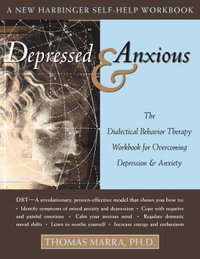
Depressed and Anxious
The Dialectical Behavior Therapy Workbook for Overcoming Depression and Anxiety
Paperback
RRP $49.35
$25.25
OFF
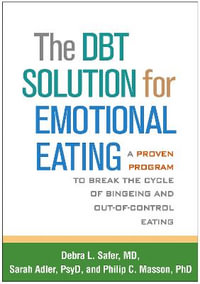
The DBT Solution for Emotional Eating
A Proven Program to Break the Cycle of Bingeing and Out-of-Control Eating
Paperback
RRP $51.99
$41.25
OFF
